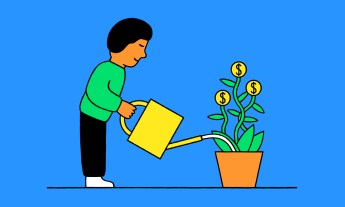
This post is part of TED’s “How to Be a Better Human” series, each of which contains a piece of helpful advice from people in the TED community; browse through all the posts here.
I’m sure you’ve heard of Murphy’s law. It’s the old adage that states “anything that can go wrong will go wrong.”
And then there’s Parkinson’s law that essentially says work expands to fill the time available for its completion.
Now I’d like to introduce you to Paco’s law — it says “your spending will equal what you have available to spend.”
This isn’t true for every person out there. But the amount of people I have personally encountered who are struggling with getting a grip on their spending is so huge that there should be a law for it.
Here’s a weird yet helpful way to look at Paco’s law: Have you ever had to take liquid medicine, like antibiotics or a cough syrup?
Chances are, you have. And chances are, you used that little cup it comes with to take the medication instead of just pouring some into a large cup and hope you’d take the right dose.
Paco’s law is basically a way for you to pour a specific amount of something (money) into a container (a checking account) in order to ensure you only consume (spend) a certain amount.
Knowing about Paco’s law is the first step to not becoming a victim of it. How do you know if you’re overspending?
Look out for the signs:
1. You save less than 5 percent of your income
2. Your credit card balances aren’t going down
3. Your credit score is below 600
4. You have no emergency fund
5. You’ve never made a budget
6. You’ve paid an overdraft fee
Even if you’re pretty good with your money, separating your spending can help you two ways — by boosting your savings and/or refocusing your spending in a way that’s more aligned with your values.
Looking at your account balances is the bare minimum of getting your finances in order. In the health and fitness world, it’s the equivalent of not sitting on your couch all day.
Here’s how the separate spending system works:
• Set up two separate checking accounts — one checking account for all the bills and life expenses and one checking account for all the fun and bs expenses.
• Fund each account with how much you need.
• Separate your spending — only pay for bills and life expenses out of the bills and life account, and only use the fun account for the nonessentials in your life. This system only works if you make sure that you adopt this rule as a part of the operating process.
Separating your fun spending will allow you to easily impose a cut-off amount on nonessential spending. If you don’t separate your spending, you’ll need to keep close tabs on your fun spending and if you’ve had trouble keeping track of it in the past, chances are you’ll have trouble in the future unless you change the method you’re using.
This system doesn’t require tedious tracking, but it does require you to regularly look at your account balances. Once a week, give your bills and life account some attention to make sure that things look normal. For example, if you have a $1000 buffer, check in to make sure that you haven’t dipped below that buffer. And if you have, you can investigate further. You’ll also need to look at your fun account balance before you actually go out or spend money on non-essential purchases.
Looking at your account balances is the bare minimum of getting your finances in order. In the health and fitness world, it’s the equivalent of not sitting on your couch all day. I’m not asking you to be a marathon runner or come up with solutions for world peace — I’m basically asking you to do the bare minimum. Please, look at your fun account balance whenever you plan on spending money from that account, and look at your bills and life balance every week.
Remember: The quality of your financial decisions can be drastically improved by avoiding an environment where you will be tempted to make bad decisions.
Here are four pro tips to make sure you stay on track.
Tip #1: Build a buffer
It’s nice to have a buffer in your bills and life account. We all have a bunch of bills that get paid throughout the month, and a buffer will be helpful if there are any weird timing issues, like having the bulk of your bills due at the beginning of the month.
An ideal buffer is an entire month’s worth of expenses, but less can work too. You could slowly build up your buffer by adding a little bit more to your bills and life account until you have a month’s worth of expenses on hand.
A faster but more austere method to building a buffer is to drastically or completely cut your fun spending for a month or three. I don’t love deprivation, but in short spurts it can work like a sprint.
If you don’t have enough of a buffer, you might need to spend some time figuring out a schedule for paying your bills. Usually, you can call and have those due dates changed. Yes, you have to sit down and make phone calls and it’s annoying, but the effort is worth the confidence you’ll feel that your system is set up to work properly.
Tip #2: Don’t bring your bills and life debit card to a fun situation
If you’re going out for a night of fun, leave your responsible bills and life debit card at home. Do not tempt yourself with it. When you’ve had a few libations and you’re feeling full of emotion and want to buy drinks for everyone at the bar, it’s best not to have that temptation present.
Remember: The quality of your financial decisions can be drastically improved by avoiding an environment where you will be tempted to make bad decisions.
Making yourself wait any length of time to buy a nonessential item you want is a good way to train your brain to get used to delayed gratification.
Tip #3: Be conscious of the natural human drive for more
The hedonic treadmill is a concept that says humans will keep relatively stable levels of happiness despite positive or negative events. Someone on the hedonic treadmill is trying to find happiness by constantly seeking pleasure.
Imagine a young person who grew up poor. They dream of an apartment to call their own, and they think it’s all they will need to feel happy.
This person does everything right and circumstances are on their side, and at 22, they’ve finished college, secured employment and got that apartment of their own. This person is happy.
But in two years, their good friends move from a rented apartment to a rented house, and suddenly that apartment is lackluster in comparison.
This person works hard, gets a promotion and can afford to rent a house so they do. Exciting, but a year later, their friends buy a house. Now this person’s expectations of what they thought would make them happy have gotten more expensive.
There isn’t anything inherently wrong with growth and improvement or with setting goals, achieving them and then setting higher ones. But the constant drive for more can be damaging when you are not conscious of your motivation or of the fact that you’re even on the hedonic treadmill.
If we think that our wellbeing and happiness can only come from external pleasure, we will be trapped on the hedonic treadmill and no matter how much money we make or how much power and status we have, we’ll never feel like we have enough.
An alternative to the hedonic approach to happiness is the eudaemonic approach. It can be summarized as an approach to well-being through six dimensions: “(1) self-discovery; (2) perceived development of one’s best potentials; (3) a sense of purpose and meaning in life; (4) investment of significant effort in pursuit of excellence; (5) intense involvement in activities; and (6) enjoyment of activities as personally expressive.”
Keeping your spending separate only requires some effort on your part — and that’s something I know you are more than capable of.
What I love about this approach is that it’s personal. It is not one size fits all. It’s a much more sustainable approach to happiness and that in itself is a radical act in a consumer-driven society.
Here are two very practical ways that you could work with the hedonic treadmill. One is to step off it temporarily by choosing not to buy nonessentials for a period of time. Try 30 days, or if you’re feeling wacky, a few months or a whole year!
Another method that keeps you on the treadmill but in a trickster sort of way is to keep a “buy” list for nonessentials. Create a list of all the things you want to buy. Feel free to go full nerd on it: Do research, make notes, make it a handsome list. Any time you want to buy something, put it on that list. Then, make a rule for how long a thing needs to be on the list before you buy it — it could be 24 hours or a few months. Making yourself wait any length of time to buy a nonessential item you want is a good way to train your brain to get used to delayed gratification.
Tip #4: This system only requires your effort, not your skill
This method of managing your finances doesn’t require technical skills. It’s not like dunking a basketball or dribbling one. It only takes your time and effort to get it up and running and then some more time and effort to maintain. There is no reason to think you can’t do either of those things.
As a general rule, I think it’s silly to fail at things that don’t require skill and only require effort. Effort is something you can control; you could even make it a habit. Skill takes a lifetime of practice, patience and time — multiplied by effort. Keeping your spending separate only requires some effort on your part — and that’s something I know you are more than capable of.
Excerpted from the new book Finance for the People: Getting a Grip on Your Finances by Paco de Leon. Copyright © 2022 by Paco de Leon. Published by arrangement with Penguin Life, a division of Penguin Random House LLC.
Watch Paco de Leon’s TED original video, which is part of the series The Way We Work. Go here to catch up on all the other episodes:














